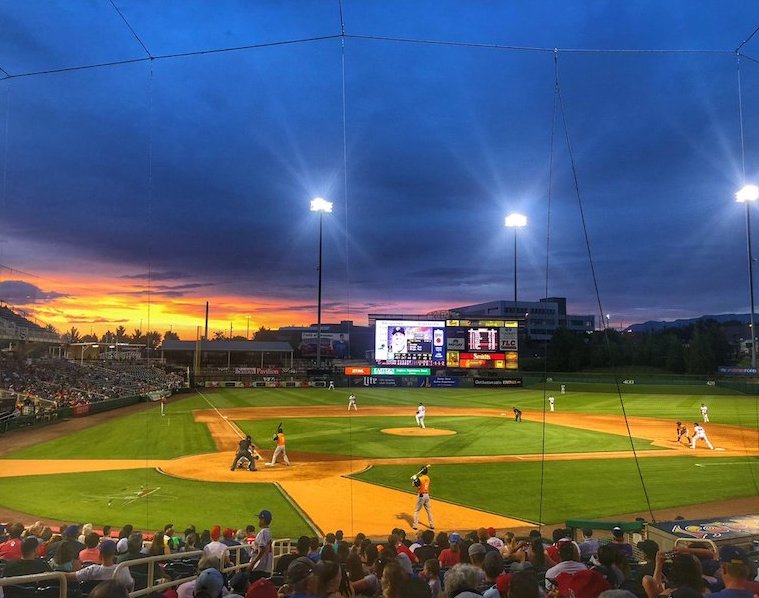By Clint Belau
Transition. The word on it’s own can elicit emotions that cover the entire spectrum. Year one of not only being home to the Albuquerque Isotopes Triple-A baseball team, but also being the “temporary” home to the USL’s New Mexico United soccer team certainly did that.
To accommodate soccer, we had to flip the field back and forth eleven times throughout the baseball season. Due to our semi-famous hill in centerfield, our soccer layout was forced to run from the first base line toward left field, which obviously affected home plate, the pitchers mound, our entire infield, the majority of the outfield and portions of the warning track. This is an issue that is seemingly invading baseball stadiums nationwide, and in what will seem like a strange plot twist, I’m going to tell you why we shouldn’t be so angry about it. Spoiler alert: it’s because being angry about it doesn’t do any good.
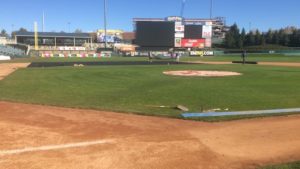
I realize that all of you who are going through similar processes right now may be dealing with entirely different sets of variables that change things for you considerably. I am admittedly a baseball guy. I got into field management for the purpose of caring for baseball fields. I am extremely fortunate to have a beautiful ballpark in my hands, and I have the strong support of my GM and front office behind me. All that being said, this season of having to deal with the transitioning led me into some dark times, and I fear I’m not the only one. So here’s to hoping I can help you get through it as well.
It’s your field, command respect
I think it’s widely perceived – and probably with good reason – that the soccer team’s personnel think we are only here for them. There isn’t a respect for what the field is being put through as a result of having to make this all work. What has worked for me is simply being vocal about it, and commanding respect.
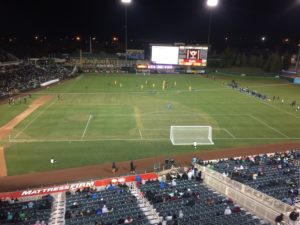
It doesn’t matter how someone with no experience in the sports field management thinks you should cut your grass, secure some temporary goal anchors, or lay out sideline protection. What matters is what you’re comfortable with, what works for you, and what’s best for your field. You might be the only advocate your field has, so it’s your duty to protect it. Set your guidelines for field use, communicate those guidelines, communicate them again, and again, and don’t be reluctant to enforce them. If that occasionally makes you the bad guy, then that’s the sacrifice you have to make.
Trust me, I’m not getting any calls from anyone with the soccer team to go have drinks, but I can guarantee you that they respect the dedication I have to my field.
Trust the process/trust the people
This has been a “do as I say, not as I do” situation in the past, but I’m constantly trying to improve upon it. My tendency has always been if I do it myself, I know it’s being done right. I’ve slowly learned to allow myself to trust others more, and this was a big year for that. I was fortunate to be able to select the company we worked with on the soccer transitions. Mountain West Golfscapes, who not only built the field at Isotopes Park, but still handles our yearly laser grades and performs our aerations, was available and willing to work with us on the soccer transitions.
Being familiar with the company and their work certainly helped my stress level. The amount of trust I have in them, and the respect they consistently show for my field is paramount.
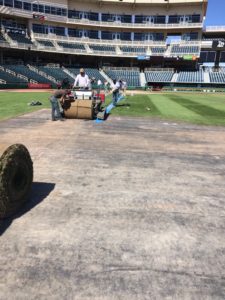
The area where I need the most improvement is on our flips back to baseball. I have to allow my assistants to take ownership of things, and trust that it will work out. Whether it’s performing granular/spray applications, resurfacing the home plate area, skin work, edge detail, hand watering hot spots, I need to trust that I’ve hired the right people, and have trained them to our standards. Between March 1 and September 15, 2019, I took one day off. I don’t say that to brag about how dedicated I am to the field. I say that as someone who’s embarrassed of how untrusting I am of other people, and knowing I have to change that. Physically and mentally, I can’t go through another season like that. From the morning of each in-season soccer match, through the evening of the following day, I was here for 38 hours straight. So if this is you, stop it. Let your people work for you, give them the training they need, and allow them to prove you’re a good leader.
Life on the edge
For us baseball folk, our edges are our babies. They are the most delicate, awe-inspiring, pride-inducing areas of our fields. The seamless transition from lush, green grass to a perfectly manicured infield can bring a single streaming tear to the cheek of any deeply invested groundskeeper.
Now, imagine a dozen significantly less invested men, marching their way toward those very edges with pick axes and bull-nosed shovels thrown over their shoulders. Their mission: destroying those edges and removing 3/4-inch of material to make the soccer sod transitions smooth. That is the stuff from which nightmares are born. Something we work every day of the season to maintain with the highest of standards having the tools of destruction thrown at it over and over is not easy on the heart. However, circle back to the part about trusting the process and the people, and you’ll have a better understanding of how I got through it.
As a whole, we actually had a lot more success maintaining our edges throughout the season than I anticipated. It feels weird to say, but I think reestablishing those edges during each flip may have been a positive. The obvious area of struggle was the spot on our third base sideline, where we would lay plywood for all of the machinery to cross over to the skin. That is just an area where I had to concede the loss, and just increase the amount of times we removed and re-sodded.
Mounds and mounds of work
We removed/re-built our pitcher’s mound eight times this year. In spring, the prospect of that only piled onto the mountain of disdain I had for the entire process.
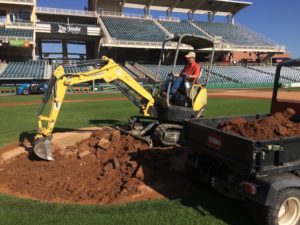
The morning of a flip back to baseball was reserved for sod removal, which handcuffed us in terms of doing much of anything on the field. I found it best to dedicate all four of us to building the mound that morning. By the time Mountain West was wrapping up its removal process around noon, I would be able to peel off two guys to go start mowing, while my lead assistant and I would continue to work on some shaping/detail. After another hour or so, I would peel off and start working the skin, while he finished final compaction/shaping. I found that rather than having one or two guys struggle with building the mound on their own, having all four of us working together for the bulk of it absolutely helped our overall temperament, efficiency, and end result.
By August, the process of re-building the mound was something I looked forward to. There is a decent chance that was because I had already been at the park for 24-plus hours and I was near delirium, but that doesn’t make it less true. Whether it was the camaraderie, the sheen of a fresh mound, or the sense of accomplishment, re-building the mound was the area where my outlook on the process drastically changed throughout the season.
Post-season problems
Here’s where it gets ugly. Following the completion of the Isotopes season, we installed the soccer sod that would stay in place for 59 days. During that time, the roots on the sod obviously grew…and grew…and grew. By the time we were taking off the sod at the end of October, we had root contamination at 1-½-inch-plus depth into our skin and warning track. While I certainly expected to have some contamination, that was a punch in the gut. We just recently (November 14) completed the process of removing – and replacing – 2 inches of our infield and warning track areas that were affected. All of that set our positional back arc re-sods back a few months while we waited to match our final grade of the new infield. That brought us much closer to dormancy season, and brought my frustration level higher and higher. However, since I’m working on being positive, all of [ital>that<ital] allowed us to amend another 175 tons of fresh DuraEdge into our infield, which leaves me excited for next year.
Choose your attitude
My former boss, Ernie Lansford, preached to us daily to choose our attitude. At the time, I was in the pro audio industry, wasn’t particularly happy in life, and Ernie seemed to hold the title of the most annoyingly positive person I had ever met. As I worked my way into a career in baseball, I stole that title from him. I had become Ernie. Every day was the best day of my life, and everyone I came in contact with knew it. Nothing could bring me down. Then this soccer thing happened, and I relinquished the title back to him. I’m now on the quest to get myself right and take that title back!
Transitioning back and forth from soccer to baseball is challenging, absolutely. It can be frustrating, certainly. It has a negative effect on my field, definitely. It provides no perceived pro to offset all of the cons, true. But it’s also seemingly not going away.
So I can sulk about it, hate it every day, and allow it to suck the pride and joy I feel for my baseball field, or I can find a way to deal with it.
Everyone’s situation is different, and I am not one to project how I live my life onto you, but I know that when I look at baseball fields around the country at all levels, I see so much good. I see so much pride at work. I see so much dedication to providing the best possible playing surfaces we can for baseball players at all levels. Please don’t let this change that.
It’s so easy to be negative, to sit in our shops texting people about how angry it all makes us and how burned out we are. Rather than fueling the fire of frustration, we need to remind ourselves why we got into it in the first place, help each other get back up, and help each other stay positive.
Clint Belau is head groundskeeper at Isotopes Park, home of the Triple-A Albuquerque Isotopes (and home of the New Mexico Untied for the foreseeable future). Belau was awarded the Presidential Commendation for excellence in sports turf by the Pacific Coast League in 2018, and again in 2019.


